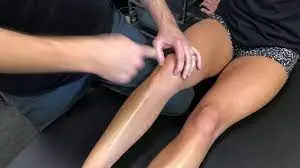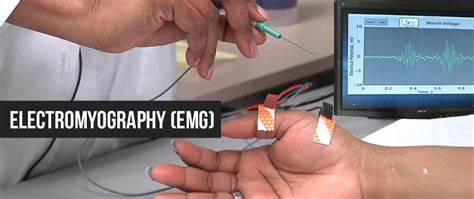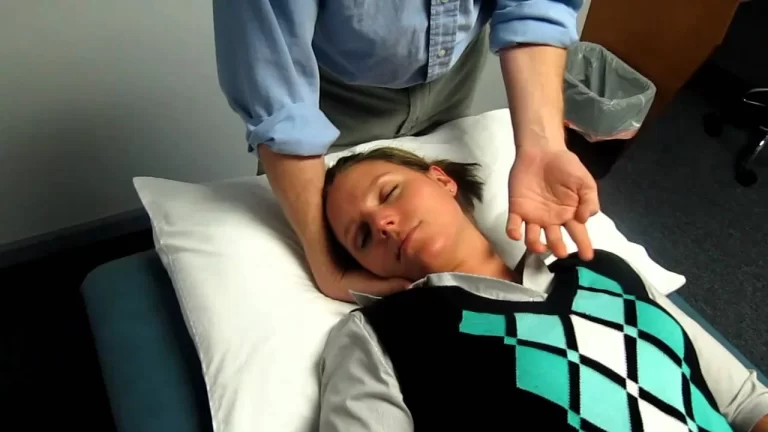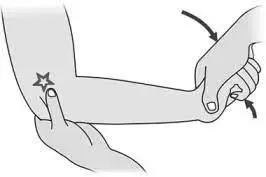Hoffa’s Test
Table of Contents
Introduction
Hoffa’s Test, also known as the Patellar Fat Pad Impingement Test or Hoffa’s Sign, is a physical examination test used by healthcare professionals, particularly in orthopedics, to evaluate for potential issues in the infrapatellar fat pad, a fatty tissue located just below the kneecap (patella).
This test is frequently used to assess knee pain or discomfort, particularly when it affects the front of the knee.
Hoffa’s test is used to clinically identify infrapatellar fat pad impingement. One of the reasons for anterior knee discomfort is impingement of the infrapatellar fat pad (Hoffa’s disease).
Purpose
The Hoffa’s Test (also known as the patellar fat pad impingement test or Hoffa’s Sign) was developed to assist medical professionals, particularly orthopedic specialists or sports medicine practitioners, in diagnosing and assessing any potential problems with this tissue.
This test is frequently performed when examining patients who complain of knee pain or discomfort, particularly in the front of the knee.
Technique
To evaluate each fat pad, the medial or lateral side of the patellar tendon is squeezed while the knee is flexed. The knee is passively extended as long as the pressure is applied. By pressing the pad into the patellofemoral joint, this movement aggravates the discomfort.
The test is positive for impingement if pain or discomfort is felt during the final 10 degrees of knee extension.
Krumar et al. believe that Hoffa’s test should be adjusted. The knee is passively stretched by applying pressure to the proximal tibia with one hand and holding the heel with the other.
The purpose of this approach is to extend the knee to its final few degrees of normal hyperextension while avoiding direct contact with the infrapatellar fat pad. According to Krumar et al., applying direct pressure to the infrapatellar fat pad may produce discomfort in surrounding tissues, resulting in a false positive, whereas impingement should occur during terminal extension without applying direct pressure to the fat pad if the fat pad is pathological.
Evidence
There is no evidence that Hoffa’s test or its variant is sensitive or specific.
Differential Diagnosis
Hoffa pad impingement syndrome is an exclusion diagnosis, because of the large number of disorders that produce anterior knee discomfort and extension block. Bursitis and other soft tissue pathologies must be checked out. The prepatellar, superficial, infrapatellar, deep infrapatellar, and pes anserine bursae of the anterior knee can develop inflamed with recurrent microtrauma or activities demanding repetitive knee motion, such as cycling.
Patellar tendinosis, which is common in high-impact jumping sports, should also be examined. It is defined by activity-related discomfort that is localized to the inferior pole of the patella and is exacerbated by eccentric quadriceps contraction. It is also necessary to rule out intra-articular diseases such as plica syndrome, meniscal tears, articular cartilage injuries, and osteochondral lesions.
Plica syndrome develops when the partially-resorbed embryonic septa that divide the knee joint into medial, lateral, and suprapatellar compartments become inflamed as a result of trauma, misuse, long-standing patellar mal-tracking, diabetes, or inflammatory arthropathy.
Meniscus tears are most commonly caused by a severe knee injury, leading to discomfort and an intra-articular clicking/catching feeling. Hypertrophic fibrosis following ACL surgery might potentially provide mechanical barriers to complete extension. This nodule or hypertrophied graft tissue, also known as a “cyclops lesion,” has been found to develop between 1% and 10% of all ACL reconstructions and is the second most prevalent cause of reduced knee extension after graft impingement.
The Anterior interval scarring is another commonly known obstruct to full knee extension, often causing pain, reduced patellar mobility, and quadriceps atrophy. The anterior interval is the distance between the IFP and the anterior tibia, and it is frequently blamed for extension block after arthroscopic ACL restoration.
Summary
Positive Hoffa’s Test results may indicate inflammation or impingement of the infrapatellar fat pad. The condition can be caused by a variety of circumstances, including overuse, trauma, or other knee-related issues. A positive Hoffa’s Test is not a conclusive diagnosis, but rather a signal that further assessment, such as imaging scans (e.g., MRI) or further clinical testing, may be required to discover the specific reason for the knee pain or discomfort.
Hoffa’s Test, such as any other medical test or assessment, should be performed by a qualified healthcare professional who can use the results in conjunction with the patient’s medical history, Physical examination results, as well as other diagnostic procedures, are used in arriving at an appropriate diagnosis and treatment plan.
FAQ
How is Hoffa’s syndrome diagnosed?
Place the patient in a supine lying position with the knee flexed to 30-60 degrees. The examiner holds the tibia dorsally with one hand while applying direct pressure to the medial and lateral sides of the patella’s inferior pole. The identical procedure is carried out with the knee in extension.
How does Hoffa’s fat pad compression test work?
Technique. Each fat pad is examined by applying pressure to the medial or lateral side of the patellar tendon while the knee is flexed. The knee is then passively extended while pressure is maintained. The pad is forced into the patellofemoral joint, aggravating the feeling of pain.
How do you test for fat pad impingement in the knee?
Hoffa’s test for impingement of the knee fat pad:
Lie down on your back, knees bent.
Your physiotherapist or doctor will push both thumbs along each side of your patellar tendon, right below the patella.
Simply straighten your leg after that.
If you have discomfort and/or fear while doing the test, you have fat pad impingement.
What are the symptoms of Hoffa’s syndrome?
Patients suffering from Hoffa pad impingement syndrome describe a “burning” or “aching” feeling in the anterior knee that is localized deep to and on either side of the patellar tendon next to the inferior pole of the patella. This is most frequent when the knee is fully extended, dynamically extended, or in prolonged flexion.
Why is it known as Hoffa’s fat pad?
Neither of these titles (Hoffa was the name of the German orthopedic physician who identified the illness) nor the discomfort is especially attractive. Fat pad impingement is a disorder that causes discomfort in the knee joint due to inflammation surrounding the appropriately termed fat pad.
What is Hoffman’s fat pad syndrome?
The fat pad on the Hoffa functions as a protective cushion, separating the kneecap from the shin and thigh bones. This gets bloated, inflammatory, and painful if it is squeezed, crushed, or injured. It grows in size after being swelled and is more prone to be pinched again.
Reference
- Hoffa’s Test. (n.d.). Physiopedia. https://www.physio-pedia.com/Hoffa%E2%80%99s_Test
- Hoffa’s Test | Infrapatellar Fat Pad Syndrome Assessment. (2022, November 29). Physiotutors. https://www.physiotutors.com/wiki/hoffas-test/
- DuBose, M. (2023, February 22). Hoffa Pad Impingement Syndrome. StatPearls – NCBI Bookshelf. https://www.ncbi.nlm.nih.gov/books/NBK589637/
- Bourjij, A. (2023, July 3).Symptoms, prevention, and therapy for Hoffa’s Fat Pad Syndrome. Bodytonic Clinic. https://bodytonicclinic.co.uk/hoffas-fat-pad-syndrome/
- Macrina, L. (2021, February 24). Anterior Knee Pain – A Fat Pad Irritation Test. Physio Network. https://www.physio-network.com/blog/anterior-knee-pain-a-test-for-fat-pad-irritation/
- Clinic, M. P. (2023, September 7). Hoffa’s Test. Mobile Physiotherapy Clinic. https://mobilephysiothera







